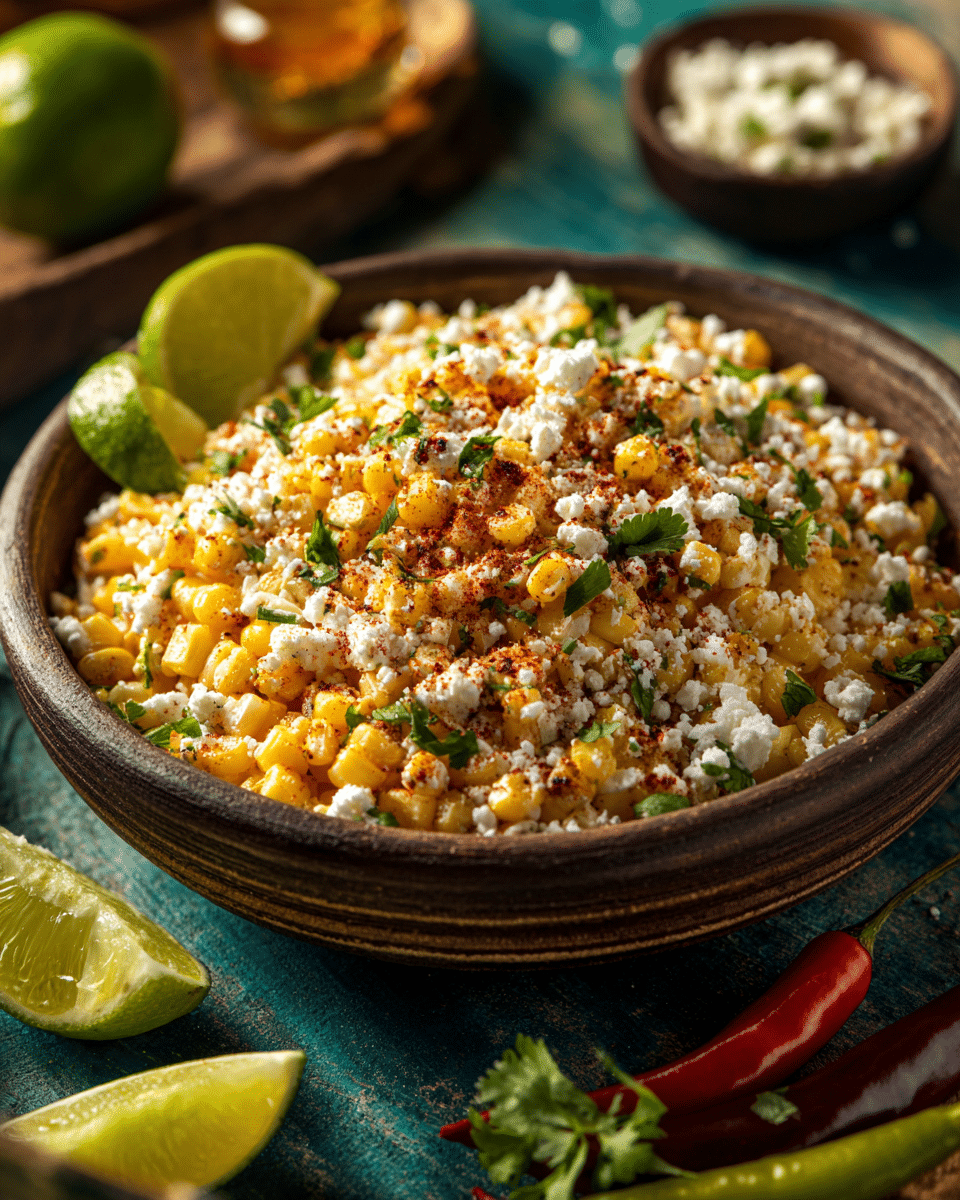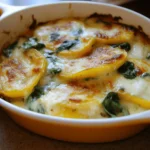Esquites is a beloved Mexican street food that transforms corn kernels into a warm, creamy, and tangy snack packed with flavor. Traditionally sold in cups by street vendors, this dish combines sautéed corn with a creamy dressing, zesty lime juice, crumbled Cotija cheese, and a sprinkle of chili powder.
FULL RECIPE
Ingredients
- 4 cups fresh or frozen corn kernels (about 5–6 ears of corn)
- 2 tablespoons unsalted butter
- 1/4 cup mayonnaise
- 1/4 cup Mexican crema (or sour cream)
- 1/2 cup crumbled Cotija cheese (plus extra for garnish)
- 2 tablespoons fresh lime juice (about 1 lime)
- 1/2 teaspoon chili powder (plus more for garnish)
- 1/4 teaspoon smoked paprika (optional)
- 1/4 teaspoon salt (adjust to taste)
- 2 tablespoons chopped fresh cilantro (for garnish)
Directions
- Cook the corn: In a large skillet over medium-high heat, melt the butter. Add the corn kernels and sauté for 5–7 minutes, stirring occasionally, until the corn is lightly charred and cooked through.
- Mix the dressing: In a medium bowl, combine mayonnaise, Mexican crema, lime juice, chili powder, smoked paprika (if using), and salt. Mix until smooth and well blended.
- Combine corn and dressing: Add the cooked corn to the bowl with the dressing. Toss until the corn is evenly coated in the creamy mixture.
- Add the cheese: Gently fold in the crumbled Cotija cheese, reserving a little for topping.
- Garnish and serve: Spoon the Esquites into serving cups or bowls. Top with extra Cotija cheese, a sprinkle of chili powder, and chopped cilantro. Serve warm with lime wedges on the side for extra zing.
Nutrition Facts
- Calories: 210
- Protein: 5g
- Total Fat: 14g
- Saturated Fat: 6g
- Cholesterol: 20mg
- Carbohydrates: 20g
- Fiber: 2g
- Sugars: 4g
- Sodium: 330mg
- Vitamin A: 8% DV
- Vitamin C: 10% DV
- Calcium: 8% DV
- Iron: 4% DV
The Cultural Roots of Esquites
Esquites is a quintessential example of Mexican street food culture, deeply rooted in the country’s agricultural history. Corn, or “maíz,” has been a staple in the Mexican diet for thousands of years, and esquites represent one of the many creative ways it is prepared. The name comes from the Nahuatl word ízquitl, meaning “toasted corn,” and while the modern version is often sautéed, the spirit of the dish remains the same—corn as the star ingredient, celebrated for its versatility and flavor. Esquites are not just a snack; they are a connection to Mexico’s pre-Hispanic heritage, enjoyed at fairs, markets, and national celebrations like Independence Day.
The Signature Flavor Profile
The flavor of esquites is a masterful balance of sweet, savory, tangy, and mildly spicy notes. The natural sweetness of corn is enhanced through sautéing, which brings out a slightly caramelized flavor. The creamy richness from mayonnaise and Mexican crema provides a smooth texture, while Cotija cheese adds a salty, crumbly contrast. Fresh lime juice brightens every bite with acidity, and chili powder introduces a gentle warmth. This layered flavor profile is what makes esquites so addictive—it excites every taste bud without overwhelming the palate.
Nutritional Value and Health Benefits
Esquites, when made with fresh corn and moderate amounts of dressing, can be a surprisingly nutritious dish. Corn is naturally rich in dietary fiber, which supports digestion, as well as B vitamins like thiamine and folate. Cotija cheese provides calcium and protein, while lime juice offers vitamin C and antioxidants. By adjusting the mayonnaise and using light crema or yogurt, you can reduce the fat content without sacrificing creaminess. Adding fresh herbs like cilantro also boosts vitamin K and plant-based compounds that support overall health.
Regional Variations Across Mexico
While the core concept of esquites remains consistent, there are many regional adaptations. In central Mexico, vendors may serve esquites in a broth-like mixture flavored with epazote, a traditional herb with a distinctive taste. In coastal regions, shrimp or crab meat is sometimes added for a seafood twist. Northern Mexico might feature roasted corn for a smokier flavor, while some southern areas incorporate chili oil for extra heat. These variations demonstrate how adaptable the dish is while still holding onto its core identity.
Modern Twists and Creative Additions
Contemporary chefs and home cooks have embraced esquites as a base for culinary creativity. Some add crispy bacon bits for a savory crunch, while others mix in diced avocado for creaminess without additional dairy. Vegan versions often replace Cotija with plant-based cheese and use vegan mayonnaise. For a more gourmet presentation, esquites can be served in roasted bell pepper halves or atop grilled zucchini boats. These adaptations keep the dish fresh and relevant while appealing to a broader range of dietary preferences.
Serving Ideas for Different Occasions
Esquites shine in casual street food settings but can also be elevated for formal occasions. For parties, they can be served in small clear cups with mini spoons for easy handling. At backyard barbecues, they make a perfect side dish alongside grilled meats and vegetables. They can even be transformed into a topping for nachos, baked potatoes, or tacos, adding a burst of flavor and texture. In more traditional presentations, serving them with warm tortillas allows guests to make their own esquite-filled wraps.
Best Pairings for Esquites
Pairing esquites with complementary foods and beverages enhances the eating experience. They go exceptionally well with grilled dishes such as carne asada, chicken fajitas, or fish tacos. As a drink pairing, agua fresca made with watermelon, pineapple, or hibiscus balances the mild heat of the chili powder. For an alcoholic option, light Mexican lagers or a refreshing michelada provide a crisp contrast to the creamy corn. Desserts like paletas (frozen fruit pops) or flan offer a sweet finish that complements the tangy richness of esquites.
Storage and Reheating Tips
While esquites are best enjoyed fresh and warm, they can be stored in the refrigerator for up to three days. To store, place them in an airtight container, keeping garnishes like cilantro and extra Cotija separate until serving. When reheating, use a skillet over low heat to gently warm the corn without overcooking it, adding a splash of milk or cream to revive the sauce’s creaminess if needed. Avoid microwaving for long periods, as this can make the corn tough and the dressing separate.
Common Mistakes to Avoid
One common mistake when making esquites is overcooking the corn, which can cause it to lose its sweetness and turn mushy. Another is adding lime juice too early, which may cause dairy-based dressings to curdle. It’s also important to season properly—under-salting can make the flavors dull, while too much chili powder can overpower the natural sweetness of the corn. Lastly, skipping the step of lightly charring the corn means missing out on the deep, smoky notes that elevate the dish’s flavor profile.
Making a Healthier Version
For a lighter take on esquites, consider using Greek yogurt in place of mayonnaise and crema for added protein and fewer calories. Reduce the amount of cheese or choose a lower-sodium alternative to keep salt intake in check. Adding extra vegetables like diced red bell pepper, zucchini, or even spinach can increase the nutrient density. Roasting the corn in the oven or on a grill with minimal oil instead of frying in butter also helps lower fat content while maintaining a delicious smoky taste.
Advertisement
Esquites in Mexican Independence Day Celebrations
During Mexican Independence Day, esquites become more than just a snack—they are a festive expression of national pride. Street vendors across Mexico dress their stalls in red, white, and green while serving hot cups of esquites to the crowds gathered for parades and fireworks. Families make large batches to share at home, often alongside other iconic dishes like pozole and tamales. The act of preparing and sharing esquites during these celebrations reinforces community bonds and honors Mexico’s rich culinary traditions.
Conclusion
Esquites with Cotija and lime is more than a flavorful snack it’s a dish that tells the story of Mexico’s deep connection to corn, creativity in the kitchen, and love for bold, balanced flavors. From its humble street food beginnings to its place in modern culinary innovation, esquites continues to evolve while holding onto its cultural essence.






